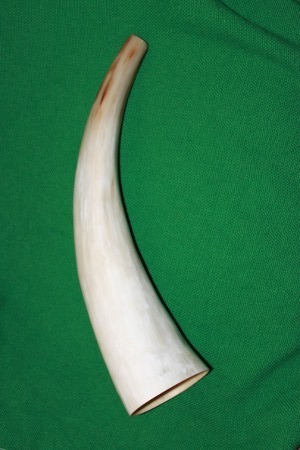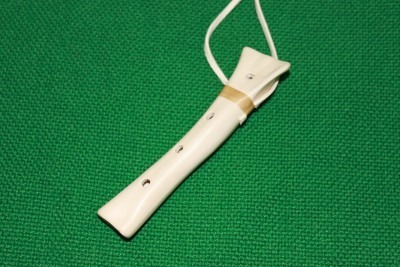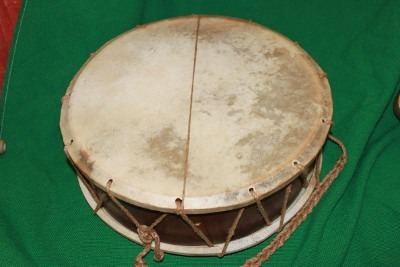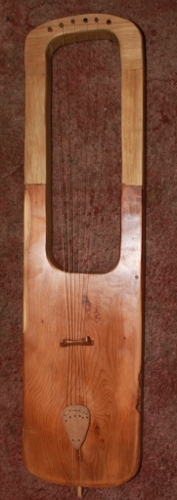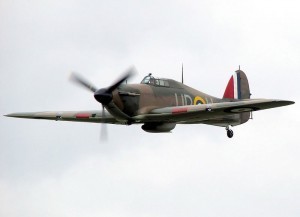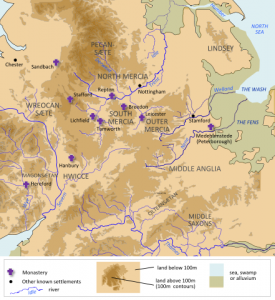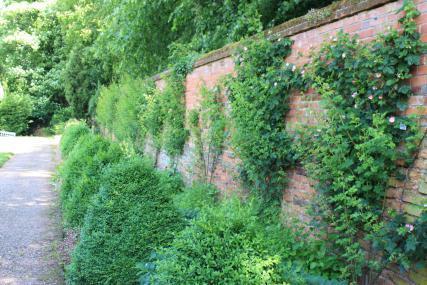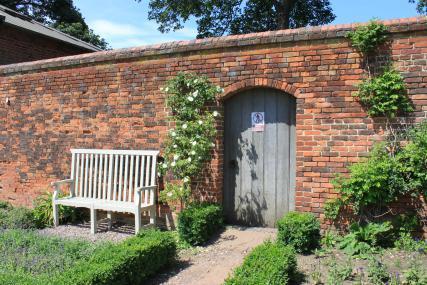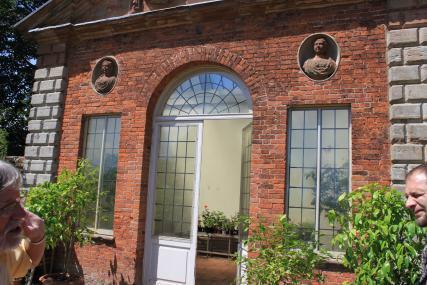Richard Denning's Blog, page 6
September 27, 2013
Anglo Saxon Musical Instruments
I now own 4 replica instruments bases on Anglo-Saxon originals so I thought I would show them today.
First I have the Horn. This is an Ox-horn. Horns were used in battle as signals but also in ceremonial matters. The lord of a hall might summon his people to feast by standing at the door and blowing the horn.
It is played by holding it in the corner of your mouth and blowing across it,
Next up is the bone flute. Many of these have been found in burials – usually made of sheep or dear bone. They have 3 holes but the hole at the end can be blocked as well to create more notes.
Drums were certainly used. There are more difficult to replicate as little survives – being made of animal skin and wood.
Finally here is my lyre. Its made of yew. (various woods were used). It Has 6 strings and can create a range of chords, notes and a good deal of noise. We are lucky that Kind Redwald of East Anglia was buried with a Lyre which mostly survived and allows for a decent replica.
Here is a video of me playing (badly) these instruments. I don’t think I will start a musical career!
September 22, 2013
Speaking like an Anglo Saxon
When the Angles, Saxons and Jutes came to the shores of Britain they were speaking a language called old English that is close to Old German – the language that evolved back in their homelands. 16 centuries later modern English has evolved through the impact of invasion, religion and time. Following the coming of the Augustine mission in the late 6th century Latin came into use in the churches and monasteries that sprang up. This had a major impact on the terms and phrases used to talk about churches services whilst the common day to day life still went on in Old English. In the 9th and 10th centuries it was the mixing in of Norse as a result of the Viking invasions and settlements that brought many new words along. A century or two later the Normans invaded bringing the French language with them. The language was used by the ruling classes and for pretty much all legal goings on. The blending of Old English and French brought us Middle English, the language of Chaucer. Middle English continued to evolve over the centuries to Modern English.
So after all this time is there much left of Old English? Well the answer is more than you might think.
Although pretty much all our technical words come from Latin, Greek or French the common words that we all us every day and make up the bulk of the words in a sentence can be traced back to Old English. Of course over that time words order and sentence structure has altered. We no longer use cases much in English. Never the less we can list many words that come from that distant time.
Thanks – Þancas (THAN-kahs) Yes – Gēse (YEH-zeh) No – Nese (NEH-zeh) Help = Help
Axe =æcs Angel = engel After = æfter Apple – æppel
Back bæc Daughter dohtor Man=mann Name=nama You=ēow
Dead=dēad If=gif On=on It=hit On=On
King= cyning Queen=cwēn Child= cild
Rain =regn Sword =sweord
Us=ūs Up=Upp Under=Under
In fact it is estimated that as many as half our commonly used words date back 15 centuries and more. They tend to be the shorter words in our language and tend to relate to mundane and day to day words used to describe the human body, cooking, eating, sewing, animals, farming and the weather. Almost all the little linking words like in, on, it, up etc are Old English.
In England the region where the dialect is closest to the sound of Old English is probably the Black Country. The word endings with ‘en’ are used in conversation as in ‘gooen’ (going), callen (calling) and the vowel ‘A’ is often pronounced as ‘O’ as in bonk (bank) sond (sand), hond (hand) and mon (man) is often the case in Old English words.
Want to speak like an Anglo-Saxon? If you are speaking Modern English You are not doing badly right now.

September 15, 2013
15th September 1940 The Hardest Day
Today -15th September in 1940 was the Hardest day of the battle of Britain. It is now known at Battle of Britain day.
After the Fall of France most people believed that an invasion of the UK was only a matter of time. First however the Germans had to over come two obstacles – the Royal Navy and the Royal Airforce. The British Navy was at this time the largest in the world. Germany simply could not sail across the channel because the Royal Navy would have blown their transports out of the water. Likewise the RAF was a problem. Transport ships would be vulnerable to Bomber command and also to the Spitfires and Hurricanes of Fighter Command.
The German answer was simple – destroy the RAF and then use air superiority to sink the Royal Navy. Then invade.
So on 10th July the Germans began attacking the RAF. By the 7th September after weeks of assaults the Fighter bases and fighter strength of the RAF was at breaking point. Even a few more days might means the defeat of the RAF. Yet, probably due to a Bomber Command raid on Berlin, the Germans switched targets to the British cities – in particular London. One week later the Luftwaffe decided to try a massive effort to finish Britain.
The 15th September 1940 would be the day that decided the Battle of Britain. The Germans that day launched raid after raid – pretty much their entire strength of 1500 bombers being engaged against some 400 British Fighters. But what the Germans did not realize is that one week pause, whilst they bombed the cities meant that the RAF had recovered its strength,
This day, this pivotal day, Churchill was visiting the command of 11 Group – the command directly responsible for London. He watched as the Germans deployed their full strength and was a witness as squadron after squadron of British fighters were launched to engage the Germans. At the very crisis of the battle when the Germans were swarming across the South East and London he asked the question “How many reserves do we have” The answer was “there are none.” the crisis of the Battle of Britain had arrived.
In the end the British fighter broke up many enemy formations and shot down over 60 enemy planes. Fighter command was intact and had not been defeated and the Luftwaffe had proven unable to defeat Britain. Soon afterwards Hitler cancelled plans for invasion of Britain and turned his eyes east, to Russia. Britain survived to one day become the launching pad for the liberation. of Europe
Today was the hardest day.
September 1, 2013
Origins of Mercia – Kingdom on the border
Mercia – the very name means “kingdom on the border”. The border in question was that between the English and the Welsh. These lands were where a permanent barrier and border was established between what became Wales and the rest of England. They were also the lands that saw some of the most tragic events recorded in the Welsh anals and poems. This is because much of what is now Shropshire and Worcestershire were the last parts of England to be conquered from the Welsh. the modern county of Powys is off to the west in the mountain fastness of Wales. Yet in the 6th and 7th centuries the Kingdom of Powys stretched out far into modern England, indeed nudging far out beyond Shrewsbury accross the fertile plains of Shropshire. This was the “Paradise of Powys” refered to in the Welsh poetry and mourned when finally lost in the 7th century.
What then was this Mercia – this kingdom on the border that deprived the Welsh of this paradise and pushed them west into their hills? Mercia was the last of the Anglo-Saxon Kingdoms to emerge and was not fully formed until the late 7th century. It was also the last kingdom to abandon faith in the old gods in favour of the new religion of Christianity – some parts of what now is the Black Country remaining pagan until the 8th century. The early years of this kingdom are lost in the darkest years of the dark ages – those misty decades of the 6th century where there is almost no documentation.
[image error]
Foundation
What do we know of the people who came to these “Midlands of Britain”. Who were they? Traditions trace the people back to a certain King Offa or Uffi who was king of the Angles in Jutland – Modern Denmark. At some point his people joined the migration of the Anglo-Saxons westwards in to Britain. They probably first settled in East Anglia. Then – so the stories go – Offa’s grandson Icel established a kingdom in the Trent valley around or near Lichfield and Tamwerth. He established a dynasty of kings called the Iclingas who would rule these lands – with certain interruptions for the next three centuries.
We start to emerge from the mists around the year 585. This is the year when it is thought Icel’s great grandson Creoda became kings.
Creoda may have had to fight to establish territory in the area around Tamworth and Lichield. This would almost certainly have been against the Welsh – or Roman British- still living in these regions but it may have to also have been against the Saxons of Wessex as the two tribes seem to have come into conflict in the south- eastern parts of what became Mercia – perhaps along the Thames valley or in Oxfordshire. Creoda died in the same year – 593 – as a powerful king of Wessex called Ceawlin – so was this at a now forgotten battle?
Pybba suceeded Creoda and was probably his son. We know little of Pybba’s reign other than he seems to have pushed the Mercia authority south and west into the Cotswolds. It appears during his reign some accommodation was found with the Welsh kingdoms of Gwynedd and Powys were made for these nations would become allies of Mercia soon. Pybba died around 606. He left several sons and daughters and yet they may have been too young to inherit or to exercise sufficient authority for now another king who was not of the direct decent took over.
Ceorl is a bit of a mystery. Its possible he was a cousin of Pybba and so still an Iclingas. On Pybba’s death he takes over, bypassing Pybba’s eldest son Penda. Ceorl is important because his daughter Cwenburgh married Prince Edwin of the southern Northumbian land of Deira. Edwin was a man in exile due to a rival King, Aethelfrith of the northern land of Bernia, having seized Deira and united Northmbria under himself. This marriage was a political gamble for it meant challenging the authority of Aethelfrith by giving support to Edwin. Was Mercia in an alliance with Powys and Gwynedd at the time in an attempt to oppose the power of Northmbria? We are not sure. What we do know is that Aethelfrith moved south and crushed Powys and Gwyedd at the battle of Chester. This could have destroyed the alliance and resulted in pressure on Mercia and that perhaps Edwin was there after no longer welcome at his father in law’s court because he was soon after on the road again – eventually finding support in East Anglia whereby he regains his throne. Ceorl survived the incident and reigns until about 626 AD.
Penda 626-655. After Ceorl’s death Penda was able to inherit the throne. Penda re-established the alliance with Gywenned and with king Cadwallon of that nation challenged Edwin of Northmbria. At the battle of Hatfield Chase Edwin was killed and Mercia for a while ruled all of Northumbria, even ranging as far north as to lay siege to the mighty fortress of Bamburgh. During and following Penda’s reign the struggle between the dominance of Mercia and Northumbria was played out, power flowing back and forth between the Kingdoms. Penda died in battle himself in 655 and Mercia fell under the rule of Oswy of Northumbria. Penda’s son Peada (655 to 6) was weak and did not last long and was murdered by his own wife possibly as a political move instigated by Oswy.
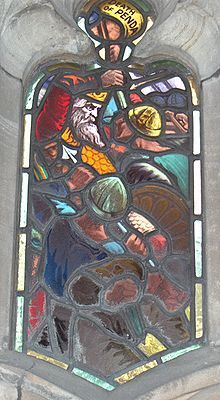
Wulfere 658-675 Wulfere was the first christian king of Mercia. In his time the Cathedral at Lichfield was founded. He was mighty in battle and having first led an uprising to wrest control of Mercia from Northumbria followed up by multiple campaigns in all directions. For most of his life no one seemed able to oppose him. He was able to expand his power by battle or politics so that at certain times all of Kent, Essex, Sussex and Surrey and even London was under his control. Via vassle states – the Hwicee, Magonstaen and Wreconstatae he pushed his power west pretty much to the modern Welsh border and – in an act the echoed on for centuries in the Welsh poems, he took over the ‘paradise of Powys’ or Shropshire.
These kings and those legendary ones that preceded them carved out and Anglo-Saxon Kingdom in the Midlands that would rise to become a major power in the 7th through to the 9th century when the Vikings invasions saw an end to a powerful Kingdom.
August 25, 2013
Beware flashing lights – A trip to Insomnia
Yesterday fellow UKGE organizer Pat Campbell and I went along to a computer gaming convention called – appropriately – Insomnia which was held at the Telford International centre. This was by invitation of the Insomnia organizers who were looking to expand their tabletop gaming area and having attending UK Games Expo in May asked us along.
Insomnia is primarily all about electronic gaming in all its formats. Michael Lambert, one of the main organizers, explained that they get around 20 to 25,000 gamers to their events. Attendees split into two types. You can either come along with your own computer (Bring Your Own Computer) of which two entire halls were filled with something like 5000 PC all hooking up to a variety of servers offering games of all types. The other alternative is to attend as a visitor(the cheaper option) and play the games offered up by the traders
 In a third main hall there were fifty or so companies all with their own games or equipment on offer and you could slide into a chair and try out their game. I was drawn to the new game World of Planes that I fancy having a go on sometime.
In a third main hall there were fifty or so companies all with their own games or equipment on offer and you could slide into a chair and try out their game. I was drawn to the new game World of Planes that I fancy having a go on sometime.
Another interesting item I spotted was a 3D printer which was printing out 3D games characters. I am sure that 3D printing could be used in the tabletop gaming world to make board game or miniature gaming pieces and I made a note of the company to look into that further.
A major element in Insomnia was the gamers getting to see or meet three types of gaming celebrities:
The ‘You-Tubers’ These are the guys who make videos of computer game play with commentary, often quite funny, and upload it to You tube. My 10 year old watches hours of these guys videos. They had a couple of dozen stars of You Tube at the convention. the queue to meet the gamers favorites stretched across the top floor!
The game designers who gave talks in well attended panels.
The gamer superstars who were fighting it out for top prizes worth thousands of pounds. The main hall had seatingfor something like 2000 and was jammed with gamers watching OTHER gamers play finals of tournaments which were shown on huge plasma screens.
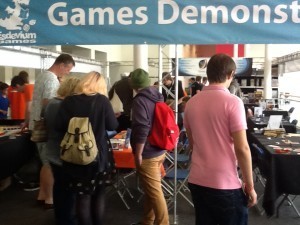 As for the purpose of our visit we went and looked at the area that Esdevium were running this year. They had a dozen tables with good choice gateway games like Settlers of Catan, Ticket to Ride and a giant version of Pandemic. I was concerned that the electronic gamers would turn their noses up at the area but in fact the gaming area was quite busy and the giant games in particular well attended. As there is an Insominia at Easter next year – in the run up to Expo – I am hopeful we can attend and work with the organisers and Esdevium to create a bigger area with other giant versions of the games as well as maybe some Roleplaying and Miniatures. I can see visual displays like dwarven Forge going down well.
As for the purpose of our visit we went and looked at the area that Esdevium were running this year. They had a dozen tables with good choice gateway games like Settlers of Catan, Ticket to Ride and a giant version of Pandemic. I was concerned that the electronic gamers would turn their noses up at the area but in fact the gaming area was quite busy and the giant games in particular well attended. As there is an Insominia at Easter next year – in the run up to Expo – I am hopeful we can attend and work with the organisers and Esdevium to create a bigger area with other giant versions of the games as well as maybe some Roleplaying and Miniatures. I can see visual displays like dwarven Forge going down well.
I do play computer games occasionally like most tabletop gamers so it was an interesting visit. What struck me most though is that the audience at Insominia were quite similar to UK Games Expo audience and that it was clear that once shown a good table top game that there WAS interest from the folk whose main love is electronic gaming – and in particular their families who brought them along. I strongly believe that if shown a GOOD tabletop game that there can be a large overlap between those who pay the main stream computer games and the growing and reviving tabletop hobby which I hope UKGE is at the heart of.
July 26, 2013
Anglo-Saxon Leechbooks
What did the Anglo-Saxons know of the healing arts and what text books did they refer to if any? Today I take a look at the oldest surviving documents from Anglo-Saxon Period relating to healing. This is Bald Leechbook.
Bald’s Leechbook
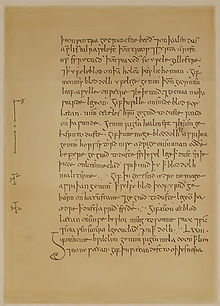
Bald’s Leechbook is the only document whose content appears to reflect a fairly pure English tradition and is free of much influence from the Meidtaeranean world. The plant names are given in English for example. The surviving manuscript, which is held at the British Museum, was probably compiled in the ninth-century, possibly around 850 AD. The books title is from an inscription which reads Bald habet hunc librum Cild quem conscribere iussit, meaning “Bald owns this book which he ordered Cild to compile.” Who Bald and Cild are we have no idea.
Saxon Traditions and the Christian Faith
What is interesting is that although this book was written during the mid Anglo-Saxon period when Christianity was well established it is clear that many beliefs from the earlier pagan religions were still held as well as the new faith. This is shown by these examples of illness caused by dark-elves whom the Saxons believed attacked people during the night or by relations with the devil.
For elf sickness, a leechdom… one must sing over the plants before one takes them and one must place them under an altar.
Make a salve for the elvish race and nightgoers and the people with whom the devil has intercourse.
Some interesting methods of treatment
For palsy, if the mouth be crooked or deficient, take coriander, crush it into a woman’s milk and put it in the healthy ear. Here they seem to be talking about what we today call Bell’sPalsy which causes paralysis and dropping of the side of the face. Not sure what putting milk in the other ear would do.
For Lice, give him boiled cabbage to eat often having fasted overnight, he will be protected from lice. Not sure how that was meant to work – unless the smell of boiled cabbage drove the lice away!
For that one be moon mad, take a dolphin’s hide, make it into a scourge, bear him with it , he will soon be better. Maybe I wont suggest this one to my patients.
For if a man’s skull be wrenched, lay the man out flat, drive in two pegs at the shoulders then lay a broad crosswise over the feet , then strike on it thrice with a hammer and it will go aright shortly. Or else I guess thepatient would have broken legs and be unable to run after you!
Not entirely without basis
Despite these more outlandish treatments areas where the Saxons has remedies that often do make sense is either in the creation of salves and ointmnents for external wounds – using herbs with known antiseptic effects or sometimes drinks for internal consumption for gripes, abdominal pains and vomiting.
For gripes and ache of the lower abdomen take bethony and wormwood, marche, radish, fennel, pound them and put into ale. Drink a cupful.
Here Wormwood does have known effects on suppressing harmful abdominal bacteria whilst fennel has antispasmodic effects and can impair a fever and both are used in herbal remedies today.
I may return to this subject again – but I probably wont suggest many of these to my own patients!

July 16, 2013
Anglo-Saxon Phrase Book
Holiday times loom for lots of people. I am off to Spain in a few weeks and I am listening to a CD of Spanish so I can learn how to order a beer.
That got me thinking about some old English Phrases that would be handy if you chose Dark Ages Britain as a Holiday destination.
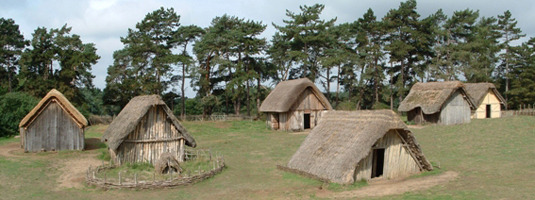
Please – Bidde (BID-deh)
Thanks – Þancas (THAN-kahs)
Yes – Gēse (YEH-zeh)
No – Nese (NEH-zeh)
“My name is ______ Ic hātte ______ . (/itch HAHT-tuh/)
Hello - Wes hāl (Good Health) (WESS haal)
Help! Help! (HELP!)
Where is the toilet, please? Hwǣr is se feltūn, bidde? (HWAIR iss seh fell-toon, BID-deh?)
Goodbye Sīe þu hāl. (be thou whole) (SEE-eh thoo haal)
and some useful vocab:
Day dæg
Night niht
Man Mann
Girl mædencild (maiden child)
Child Cild
Boy cniht (knight or knave)
Woman wóma (womb)
Son són
Daughter dohtor
Knife cníf
If you are soon off on holiday have a good one.

June 30, 2013
Castle Bromwich Hall Gardens
Right underneath the flight path of planes taking off from the nearby Birmingham International Airport, mere yards from a modern housing estate and a few miles from the centre of the modern city of Birmingham is a tranquil reminder of a time when the surrounding area was just country side.
Today we visited Castle Bromwich Hall Gardens
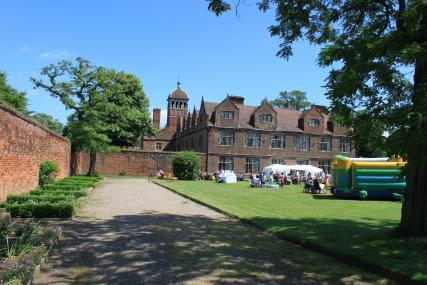
The rear of Castle Bromwich Hall
The house was built in 1599 by Sir Edward Devereux and extended by Sir John Bridgeman I about 100 years later. The Gardens were then developed by several generations of the Bridgeman Family reaching a peak of excellence around 1760. The Gardens fell into decline during the twentieth century until they were rescued by the Castle Bromwich Hall Gardens Trust in 1985.
These 10 acre walled gardens are a rare example of formal English garden design of the style popular before Capability Brown brought in landscape gardens and formal gardens went out of fashion . They are being restored as near as possible to the period 1680 to 1762 when the Bridgeman family moved to Weston Park.
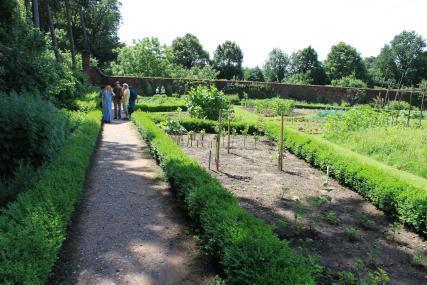
The Kitchen Gardens
The Green House and Summer House have been restored:
The Parterre style of Garden ( French term I believe) was reconstructed from engravings from the 17th century:
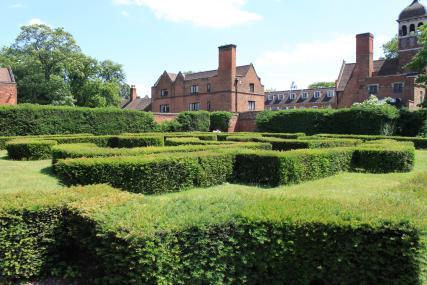
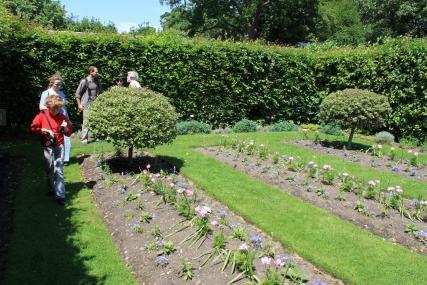
There are lots of these little well laid out gardens
All in all well worth the visit if you like Gardens and historical ones at that. There is a small tea room there. Adults are £4 entry.
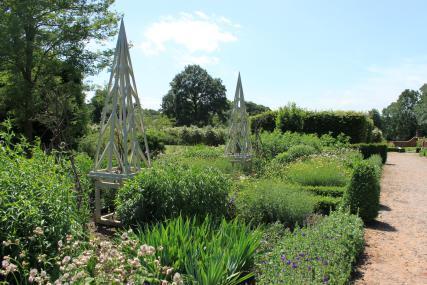


June 29, 2013
The Anglo-Saxon use of Runes
When the Anglo-Saxons came to Britain they did not use Latin script. Instead when they did write anything they used the Futhorc or runic alphabet. This is a series of between 24 and 33 letters which we find engraved on weapons such as the seax owned by the British museum.

It is also used upon the Franks casket which is from the 8th century and is in the British museum and is in the form of a riddle.
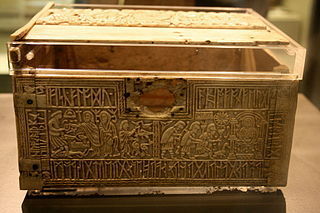
A glance at the letters show some similarities to Latin script:
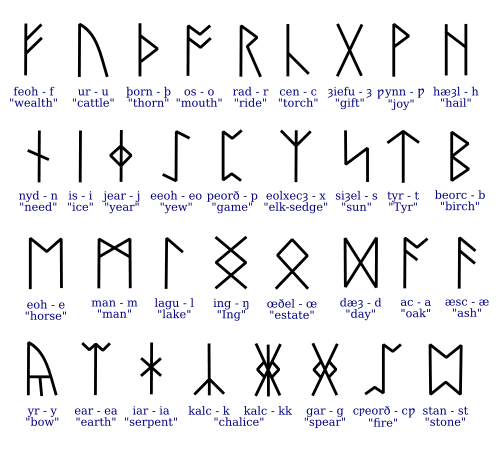
This is in fact because the Germanic races that used the letters probably adapted them old Etruscan, Italic and Greek scripts such as which evolved into the Latin script. IN other words they have a common ancestor. The Germanic races and later the Anglo-Saxons and Norse adapted shapes that have one feature in common – they are mostly straight lines. Why is this important? Well for the most part these people were not writing on parchment but stone, wood and metal because they wanted to record the runes on weapons, wooden sticks and twigs, stones slabs, on the lintle above their door etc.
Fortune telling or magic?
What use did the Germanic types and Anglo-Saxons make of these symbols. Were they JUST used to record names and facts OR was there a deeper more mystical significance.
Tacticus the 1st century Roman historian records that the German tribes would engrave runes on wooden twigs. Their shamans would caste them on the ground and then randomly pick up three. How they interpreted the combinations is not known however. The runes were apparently significant in combination OR might have individual significance a clue to which might be in the names of the Runes. We know the names and attributes from Rune-poems which were written and survive from varying time periods.
Consider the Rune called Fehu:
 This is used to give us an ‘f’ sound and that letter can clearly be seen in it form. However the shape might also by a symbol for a cow or bull with horns. The fehu rune means wealth and the cow connection is that in these times one form of easily transportable money was a cow. From fehu we get the English word “fee”. So here we have a symbol that can just be used as a ‘f’ sound but also can represented wealth, money or cattle.
This is used to give us an ‘f’ sound and that letter can clearly be seen in it form. However the shape might also by a symbol for a cow or bull with horns. The fehu rune means wealth and the cow connection is that in these times one form of easily transportable money was a cow. From fehu we get the English word “fee”. So here we have a symbol that can just be used as a ‘f’ sound but also can represented wealth, money or cattle.
Look at the tyr or teiwaz rune:
This symbol is use for the ‘t’ sound but also is seen as representing a spear. the spear was the symbol of the war god Tiw. From his name we get our modern name Tuesday – meaning the day of Tiw. The symbol therefore has associations with battle, heroism and victory. Warriors would wear this symbol and it might be engraved on weapons or armour.
The ‘r’ sound is represented by the Raido rune:
The old English Raido is from where we get both ‘riding’ and ‘road’ . So this symbol may have been used like a St Christopher is today – to bless a journey.
Use in healing
A possible reference to the use of sticks inscribed by runes – in this case as a tool in healing is in the Nine-Herbs charm. This is a Old English mansucript that speaks of charms used for healing – mainly against poison:
A snake came crawling, it bit a man. Then Woden took nine glory-twigs, Smote the serpent so that it flew into nine parts.
Belief in magic
Certainly the Anglo-Saxon believed in the power of spells and magic. In a section of Bede’s Ecclesiastical History of England, Bede talks about how the captors of a certain nobleman found that they could not bind him and that his manacles fell off. Bede uses this to show the power of prayer BUT the nobleman’s pagan captors see it as evidence of magic:
The noble entertained him, kind ordered his wounds to be dressed, and when he began to recover, to prevent his escaping, he ordered him to be bound at night. But he could not be bound, for as soon as they that bound him were gone, his bonds were loosed …. the noble that had kept him was amazed, and began to inquire why he could not be bound; whether perchance he had any spells about him, such as are spoken of in stories. He answered that he knew nothing of those arts
Runes in common language
The word Rune is itself an old english word runa that we still use today. It is part of some other old English words. A counsellor or advisor was called a rune-knower or runwita. To whisper or tell secrets was runian meaning to rune. Someone who was knowledgeable about occult or mystical secrest was said to be runcraeftig or rune-skilled.
Although Runes fell out of use around the 10th century both as a result of the move to writing on parchment in Latin script and also due to the teachings of the church being opposed to the old pagan religions anyone trying to get inside the minds of our ancestors who lived fifteen centuries ago needs to be aware of the significance of them. There is a very good introduction to this subject - Rudiments of Rune Lore by Stephen Pollington.

June 23, 2013
Tawdry: how a modern word came from a 7th Century Saint’s name
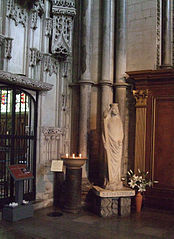
Today is the feast day of St Æthelthryth. She is a fairly obscure saint who for reasons that are not exactly clear is the patron saint of throat ailments. Whilst her patronage is unclear we can trace the origins of the modern English word tawdry from her name.
Tawdry: cheap and gaudy finery
What am I blithering about? Read on to find out.
Æthelthryth was born around 636 in Exning, Suffolk. Both she and all her three sisters were destined to found monasteries and become nuns and as a youth she took a vow of chastity. This would be expected to cause trouble when in 652 she married a local prince called Tondberct, but she managed to persuade her husband to respect her vow of perpetual virginity. Tondberct did not last long and died around 655, at which point Æthelthryth retired to the Isle of Ely, which was actually a wedding gift from her late husband.
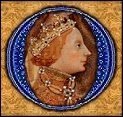
A few years later she was obliged by her family to remarry: this time to Ecgfrith of Northumbria. Despite the wedding in 670, Æthelthryth became a nun which although inituially accepted by her new husband soon became a cause of contention as he wished to consummate the marriage. Persuasion failed and now – the story goes – the king tried to take his queen from the cloister and to his bed by force. Æthelthryth fled to Ely. During this flight miracles occured. She planted her staff in the ground which became an ash tree in which she hid. Her flight was also aided by a mysterious rising of the tide which is also seen as a miracle. Ecgfrith must have decided that Æthelthryth was too much trouble because he later married another queen. Meanwhile, finally left in peace, Æthelthryth founded a double monastery at Ely in 673. She died in 679.
In 695, her sister, Seaxburh translated the remains to a new church at Ely. When her grave was opened, Æthelthryth’s body was intact and both her coffin and clothes had miraculous powers. The modern shrine of St. Æthelthryth containing the relic of her hand is at the Roman Catholic Parish church in Ely.
What about the Tawdry thing?
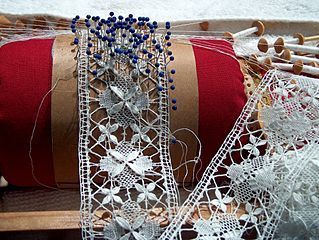
Æthelthryth’s name means “Nobly born Ryth”. Ryth is also spelt Reda and from the name we get the more familiar modern name Audrey or Awdrey. Now in later years the followers of her cult bought modestly concealing lace goods at an annual fair held in her name in Ely. As is the way of fashions by the 17th century, this lacework had become old-fashioned and of cheap of poor quality. The Puritans looked down on any form of lacy dressiness and so it also was seen as sordid. Thus from the name of a 7th century saint we get a word which we might today use in a phrase like the tawdry business of politics.


